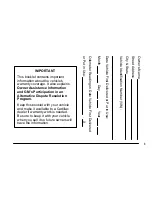
592
Operation
Tires and wheels
Tire inflation pressure changes by approxi-
mately 1.5 psi (0.1 bar) per 18°F (10°C) of
air temperature change. Keep this in mind
when checking tire inflation pressure
where the temperature is different from
the outside temperature.
Checking tire inflation pressure
Regularly check the tire inflation pressure
at least once a month.
Check and adjust the tire inflation
pressure when the tires are cold. The tires
can be considered cold if the vehicle has
been parked for at least 3 hours or driven
less than 1 mile (1.6 km).
If you check the tire inflation pressure
when the tires are warm (the vehicle has
been driven for several miles or sitting less
than 3 hours), the reading will be
approximately 4 psi (0.3 bar) higher than
the cold reading. This is normal. Do not let
air out to match the specified cold tire in-
flation pressure. Otherwise, the tire will be
underinflated.
Checking tire inflation pressure
manually
Follow the steps below to achieve correct
tire inflation pressure:
왘
Remove the cap from the valve on one
tire.
왘
Firmly press a tire gauge onto the
valve.
왘
Read tire inflation pressure on tire
gauge and check against the recom-
mended tire inflation pressure on the
Tire and Loading Information placard
on the driver’s door B-pillar
(
컄
page 585) or, if available, the tire in-
flation pressure label on the inside of
the fuel filler flap. If necessary, add air
to achieve the recommended tire infla-
tion pressure.
Warning!
G
Follow recommended tire inflation
pressures.
Do not underinflate tires. Underinflated tires
wear excessively and/or unevenly,
adversely affect handling and fuel economy,
and are more likely to fail from being over-
heated.
Do not overinflate tires. Overinflated tires
can adversely affect handling and ride
comfort, wear unevenly, increase stopping
distance, and result in sudden deflation
(blowout) because they are more likely to
become punctured or damaged by road
debris, potholes etc.
Do not overload the tires by exceeding the
specified load limit or total load limit as indi-
cated on the Tire and Loading Information
placard located on the driver’s door B-pillar.
Overloading the tires can overheat them,
possibly causing a blowout. Overloading the
tires can also result in handling or steering
problems, or brake failure.
Summary of Contents for S 450 4MATIC
Page 2: ...S 450 4MATIC Canada only S 550 S 550 4MATIC S 600 S 63 AMG S 65 AMG ...
Page 13: ......
Page 25: ...24 At a glance Exterior view ...
Page 27: ...26 At a glance Cockpit ...
Page 29: ...28 At a glance Instrument cluster ...
Page 31: ...30 At a glance Control systems ...
Page 37: ...36 At a glance Storage compartments ...
Page 40: ...39 Safety and Security Occupant safety Panic alarm Driving safety systems Anti theft systems ...
Page 85: ...84 ...
Page 357: ...356 ...
Page 499: ...498 Controls in detail Air vents ...
Page 627: ...626 ...
Page 799: ...798 ...
Page 801: ......
















































